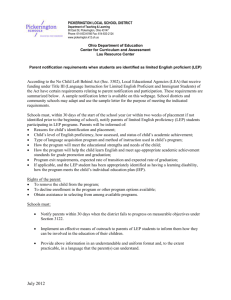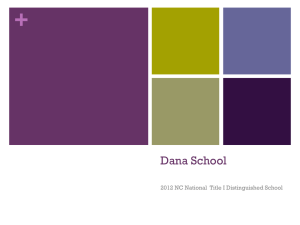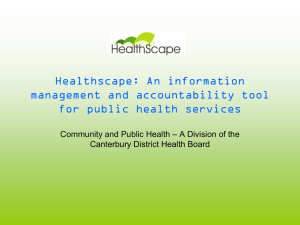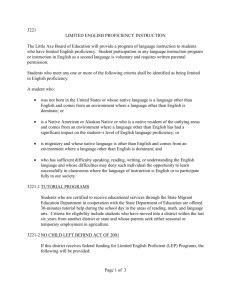T VI L
advertisement
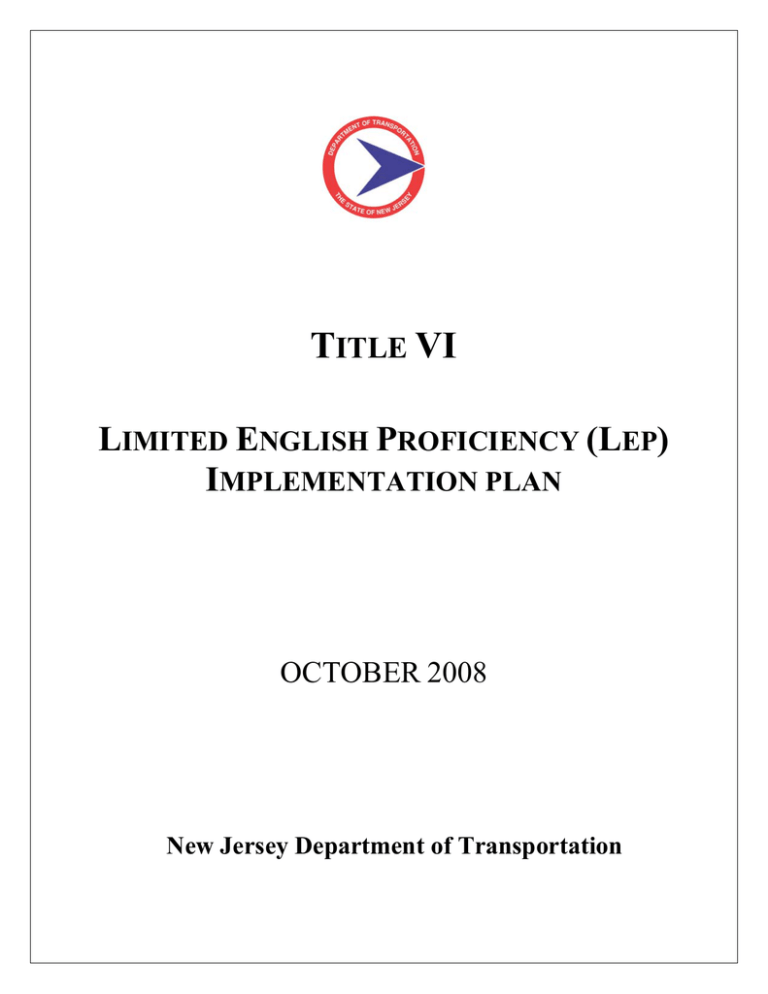
TITLE VI LIMITED ENGLISH PROFICIENCY (LEP) IMPLEMENTATION PLAN OCTOBER 2008 New Jersey Department of Transportation TABLE OF CONTENTS Page I. LIMITED ENGLISH PROFICIENCY USDOT Limited English Proficiency (LEP) Definition Who is a LEP Person? Linguistically Isolated 3 II. BACKGROUND AND AUTHORITY 3 III. 2008 UPDATE of NJDOT LEP PROGRAM Objectives Services Task/Actions Top 5 Languages Spoken in NJ 4-6 IV. ASSESSMENT: THE FOUR-FACTOR ANALYSIS 7-8 V. LEP and the NJDOT Division of Civil Rights Responsibility Compliance and Enforcement Division Responsibilities 8-10 VI. NJDOT TRANSLATION OF DOCUMENTS Vital Documents 10-12 VII. LANGUAGE ASSISTANCE Translation of NJDOT documents Services 12 VIII. FREQUENTLY ASKED QUESTIONS 13-15 APPENDIX A APPENDIX B APPENDIX C APPENDIX D APPENDIX E APPENDIX F Executive Order 13166 “Improving Access to Services for Persons with Limited English Proficiency” LEP Brochure Statewide Traffic Operations LEP Plan “I Speak Cards” Language Identification Cards Linguistics Pool 2 I. Limited English Proficiency USDOT Limited English Proficiency (LEP) Definition: Individuals with a primary or home language other than English who must, due to limited fluency in English, communicate in that primary or home language if the individuals are to have an equal opportunity to participate effectively in or benefit from any aid, service or benefit provided by the transportation provider or other DOT recipient. Who is a LEP Person? Individuals who do not speak English as their primary language and who have a limited ability to read, speak, write, or understand English can be limited English proficient, or “LEP.” These individuals may be entitled language assistance with respect to a particular type or service, benefit, or encounter. Linguistically Isolated A person in households in which no one over the age of 14 speaks English well is used as a direct measure of those persons with a severe language barrier. II. Background and Authority Title VI of the Civil Rights Act of 1964 and its implementing regulations provide that no person shall be subjected to discrimination on the basis of race, color, or national origin under any program or activity that receives Federal financial assistance. The purpose of this limited English proficiency guideline is to clarify the responsibilities of the New Jersey Department of Transportation (NJDOT), a recipient of Federal financial assistance from the U.S. Department of Transportation (DOT), in fulfilling its responsibilities to limited English proficient (LEP) persons, in accordance with Title VI of the Civil Rights Act of 1964 and implementing regulations. On August 11, 2000, Executive Order 13166, “Improving Access to Service for Persons With Limited English Proficiency,” was signed by President Bill Clinton. It directs federal agencies to ensure people who are LEP have meaningful access to services. 3 III. 2008 Update of NJDOT LEP Program The department’s LEP Guidelines were developed in 2006. The following is an update and future projection of LEP initiatives. OBJECTIVES: • To ensure that reasonable access to services are provided to those who do not read, speak, write or understand English or who are low-literacy • To provide Limited English Proficiency Guidelines to divisions throughout NJDOT to assist them in completing individual LEP Plans based on their unique interactions with the public. • Divisions are asked to address five elements in the plans: Identification of LEP persons; Development of language assistance measures; training; provide outreach & notices in LEP languages and monitor& evaluate efforts. The Division of Statewide Traffic Operations completed a Plan in 2007. APPENDIX C • As a department we are required to translate vital documents: Applications, Consent & Compliance forms, Notice of Rights, Written tests, Letter/Notices that require response, Websites SERVICES: • LEP site on Internet/Intranet under Title VI/EJ • Employee Linguistics Pool (Interpreters). Employees can either contact the LEP Coordinator directly to participate or log on to MYDOT, then under Employee Information, click on Language Skills for Linguistics Pool. Highlight language(s) they are proficient and hit save. They will then be contacted, as needed, as an interpreter. Linguistics Pool list attached, APPENDIX F • “I Speak Cards”- laminated cards in English/Spanish asking the need of customers, with pictures. Frequently used by Emergency Service Patrol. APPENDIX D • Language ID Flash Cards- lists various languages; persons can point to language they speak to get assistance. APPENDIX E TASK/ACTIONS: Identification of LEP Individuals – • Determine the number or proportion of LEP persons served or likely to be encountered on NJDOT Projects. • Determine the frequency with which LEP individuals come in contact with services offered by NJDOT through interviews and attending staff meetings. • Develop and distribute “I Speak” Cards to key personnel, departments and divisions that come in contact with LEP individuals. • Develop and distribute LEP posters and notices on a regional basis. These marketing materials will provide LEP individuals language assistance available to encourage selfidentification. • Hold public meetings and conduct outreach efforts in LEP communities in an effort to collect information in contact with through our normal operations. 4 • Track all the languages encountered on projects and in the field. Develop an access database to compile all the information collected. Information collected could include County, District, Race, language spoken, literacy level, Income, Employment status to name a few. Preparation of a Language Assistance Plan – • NJDOT Division Directors are responsible for ensuring that meaningful services to LEP persons are provided in their respective divisions. • The LEP Coordinator will monitor the program to ensure that LEP requirements are fulfilled and report results, accomplishments, and problems quarterly to the Title VI/ EJ Coordinator. Specific tasks include: • Preparing written guidelines (Implementation Plan) to assist the Division Directors develop their regional plans to meet the needs of LEP individuals in New Jersey. • Assessing NJDOT’s interpretation, translation, and other language resources to serve LEP individuals. • Addressing the various types of contact that NJDOT might have with LEP individuals including the Emergency Service Patrol, at reception desks and when contacted by telephone. • Prioritizing first-response units and other services involving access to important benefits, services, information and rights that an LEP person may have. • Identifying language resources (NJDOT staff, consultants) to assist us with our needs in ensuring that NJDOT staff members know how to access and effectively utilize LEP resources that we currently have. • Differentiating between the many types of language services providers available (World Lingo, Bablefish, etc.) and determine which ones are appropriate for NJDOT. Conducting Staff Training • Ensure NJDOT staff knows LEP policies and procedures through a series of training courses. These training courses will include individual and group activities, exercises and an overview of our LEP Guidelines. • Cultural sensitivity and communication skills – We will also train staff about the importance of Title VI and Environmental Justice to ensure that they are aware of the impacts that the lack of effective LEP program can have on a community. • Staff will be trained to effectively communicate with LEP communities. Providing Notice to LEP Persons (Future Goals) • It is very important to let LEPs know services are available and free of charge. • Notices in languages LEPs will understand. Identify areas through data and maps and prepare outreach materials and notices in the proper information. • Notices and outreach materials will be written at the 4th-6th grade reading level. • Signs will be posted in the most common places visited. • NJDOT will work with community and faith based organizations. • NJDOT will work with our Office of Communications to provide Telephone Voice Mail services in common languages. 5 • • • • Provide marketing materials and notices in local newspapers Conduct presentations and provide notices at schools, universities and churches. Provide written translation of all vital documents including but not limited to Job Applications, Consent & Complaint forms. Notices or rights, Advertisements Notices of free language services, written tests, Letters/Notices that require timely response, publications (Newsletters, Posters, Videos and websites). Partner with media outlets (NJ Television, radio stations, and ethnic and foreign language media) to develop additional materials for non-English speakers in New Jersey. Monitor and update the LEP Plan The Department is going to include quality control measures in our guidelines to ensure that we are communicating accurately and effectively with LEP community members. TOP 5 LANGUAGES SPOKEN IN NJ: Based on 2000 Census Data Spanish or Spanish Creole Italian Chinese Polish Portuguese or Portuguese Creole 6 IV. Assessment: The Four-Factor Analysis Failure to provide access to anyone that is a LEP individual in federally assisted programs and activities is national origin discrimination under Title VI of the Civil Rights Act of 1964. Title VI and its regulations require that the NJDOT take reasonable steps to ensure “meaningful” access to the information and services it provides. The following is the four-factor analysis guiding the implementation of the LEP access requirement: 1. The number or proportion of LEP persons served or likely to be encountered on NJDOT projects: The greater the number or proportion of LEP persons from a particular language group served or encountered in the eligible service population, the more likely language services are needed. Divisions within NJDOT should first examine prior experience with LEP individual and determine the breadth and scope of language services that are needed. In conducting this analysis, it is important to include language minority populations that are eligible beneficiaries of NJDOT programs, activities, or services but may be underserved because of existing language barriers; and consult additional data, for example, from the census, school systems, and community organizations, and data from state and local governments, community agencies, school systems, religious organizations and legal aid entities. 2. The frequency with which LEP individuals come in contact with the program, activity or service: NJDOT Divisions should assess, as accurately as possible, the frequency with which they have or should have contact with LEP individuals from different language groups seeking assistance, as the more frequent the contact, the more likely enhanced language services will be needed. The steps that are reasonable for servicing a LEP person on a one-time basis will be very different than those expected for servicing LEP persons daily. 3. The nature and importance of the program, activity, or service provided by the program: The more important the activity, information, service, or program, or the greater the possible consequences of the contact to the LEP individuals, the more likely language services are needed. The department needs to determine whether denial or delay of access to services or information could have serious or even life-threatening implication for the LEP individual. 4. Costs must be factored into this balancing test as part of the consideration of “resources available”: “Reasonable steps” may cease to be reasonable where the costs imposed substantially exceed the benefits in light of the factors outlined the US Department of Justice (DOJ) Guidance. A suggestion might be to prioritize so that the language services are targeted where most needed because of the nature and importance of activity involved. This four-factor analysis necessarily implicates the ``mix'' of LEP services required. NJDOT has two main ways to provide language services: Oral interpretation either in person or via 7 telephone interpretation service and written translation. Oral interpretation can range from onsite interpreters for critical services provided to a high volume of LEP persons to access through commercially-available telephonic interpretation services. Written translation, likewise, can range from translation of an entire document to translation of a short description of the document. In some cases, language services should be made available on an expedited basis. The correct mix should be based on what is both necessary and reasonable in light of the fourfactor analysis. For instance, a construction project occurring in a largely Hispanic neighborhood may need immediate oral interpreters available and should give serious consideration to hiring some bilingual staff. In contrast, there may be circumstances where the importance and nature of the activity and number or proportion and frequency of contact with LEP persons may be low and the costs and resources needed to provide language services may be high. Regardless of the type of language service provided, quality and accuracy of those services can be critical in order to avoid serious consequences to the LEP person (s) and to the department. V. LEP and the NJDOT The below matrix illustrates legal and policy considerations that require NJDOT to provide LEP persons with meaningful access to programs, activities, and services. Title VI of the Civil Rights Act of 1964 • • • • • • • • • • • Federal Law Enacted July 2, 1964 Considers all persons Contains monitoring and oversight compliance review requirements Provides protection on the basis of race, color, and national origin Focuses on eliminating discrimination in federally funded programs Annual Accomplishment and Upcoming Goals Report to FHWA • • • Executive Order 13166 Limited English Proficiency Federal Policy Signed August 11, 2000 Considers eligible populations Contains monitoring and oversight requirements Provides protection on the basis of national origin Focuses on providing LEP persons with meaningful access to services using Four- Factor criteria Annual Accomplishment and Upcoming Goals Report to FHWA Division of Civil Rights Responsibility Under Title VI The Title VI Unit, LEP Coordinator is responsible for monitoring NJDOT’s divisions’ activities to ensure meaningful access for LEP persons. This includes advising divisions of LEP requirements, implementing and assisting in developing individual program plans. Compliance and Enforcement NJDOT Division Directors are responsible for ensuring that meaningful services to LEP persons are provided in their respective divisions. The Title VI Coordinator will continuously monitor 8 their respective divisions to ensure LEP requirements are fulfilled and report annually on the accomplishments and upcoming goals relating to LEP activities to the NJDOT Civil Rights and Affirmative Action Division. NJDOT Division Responsibility The key to providing meaningful access to benefits and services for LEP persons is to ensure that the language assistance provided results in accurate and effective communication between the department and LEP person about the types of services and/or benefits available. To accomplish effective communication, the following five elements should be considered at a division level: Five Elements of a LEP Plan 1. 2. 3. 4. 5. Identification of LEP persons Develop language assistance measure Ensure staff is trained Provide outreach and notices in LEP languages Monitor and evaluation of efforts 1. Identification of LEP persons ¾ Use the first two Four-Factors: • The number or proportion of LEP persons served or likely to encountered on NJDOT projects • The frequency with which LEP individuals come in contact with the program, activity or service ¾ Use language identification cards or “I speak” cards ¾ Post notices in LEP languages of assistance available to encourage selfidentification ¾ Perform language census data analysis at statewide, county and municipal levels 2. Develop language assistance measures ¾ DOT Headquarters and regional offices to provide LEP persons with oral language assistance at reception desks and when contacted by telephone. Assistance my come through bilingual staff or voluntary community interpreters who are experienced and competent in interpreting. 3. Ensure staff is trained ¾ Ensure staff knows LEP policies and procedures ¾ Linguistic diversity and sophistication ¾ Cultural sensitivity and communication skills ¾ Staff trained to effectively communicate with LEP and telephone interpreters 4. Provide outreach and notices in LEP languages ¾ Important to let LEPs know services are available and free of charge ¾ Notices in languages LEPs will understand • Written at the 4th – 6th grade reading level ¾ Website in multiple languages ¾ Ways to accomplish: 9 • • • • • Post signs in most common places visited Work with community organizations Telephone Voice Mail in common languages Notices in local newspapers in other languages Presentations/notices at schools and churches 5. Monitor and Evaluation of Efforts ¾ Regular oversight and Plan modification of: • Current LEPs in service area encountered or affected • Current communication needs of LEP communities • Frequency LEP groups are encountered • Nature and importance of activities of LEPs • Whether existing assistance meets the needs of LEPs • Whether staff is knowledgeable of policy, procedures and implementation • Whether identified sources of assistance are still current and viable • Number and type of grievances/complaints received plan VI. NJDOT TRANSLATION OF DOCUMENTS The following charts show a.) The top ten (10) languages listed per rank as of 1990 Census spoken at home by persons five years old and over in New Jersey; and b.) The top ten (10) languages spoken throughout the three NJDOT regions compared to the overall State. NJDOT has broken New Jersey’s 21 counties into three regions in order to do business effectively across the State. The three regions are North, Central and South. North region includes: Bergen, Essex, Hudson, Morris, Passaic, Sussex, Union and Warren counties. Central region: Hunterdon, Mercer, Middlesex, Monmouth, and Somerset counties. Region South: Atlantic, Burlington, Camden, Cape May, Cumberland, Gloucester and Salem counties. a.) 19.5% language minorities in 1990, 25.5% in 2000 LANGUAGE Spanish Italian Polish German Portuguese French/French Creole Chinese Tagalog Korean Arabic 1990 CENSUS 621,416 154,160 69,145 56,877 55,285 52,351 47, 334 38,107 30,712 24,384 2000 CENSUS 967,741 116,365 74,663 41,025 72,870 76,008 84,345 66,851 55,340 47,052 10 % INCREASE +42% -25% +8% -28% +32% +45% +78% +75% +80% +93% b.) Languages NJDOT North Region Spanish 662,340 Italian 67,205 Polish 53,038 Portuguese 34,515 Tagalog 32,805 Chinese 6,435 Korean 32,805 Gujarathi 6,555 Arabic 19,190 French 10,610 Top 10 languages by NJDOT region compared to overall State State Totals 967,741 116,365 72,870 74,663 55,340 66,415 55,340 47,325 47,050 45,675 Languages NJDOT Central Region Spanish 190,070 Italian 29,535 Polish 23,910 Portuguese 18,965 Russian 17,390 Chinese 29,535 Gujarathi 17,390 Hindi 10,285 French 2,320 German 3,485 State Totals 967,741 116,365 74,665 72,835 38,565 66,415 47,325 31,395 45,675 41,005 Languages NJDOT South Region Spanish 115,300 Italian 8,885 Chinese 3,030 Tagalog 2,740 French 2,120 German 2,970 Vietnamese 2,965 Polish 1,845 Korean 1,700 Greek 1,415 The above charts indicate languages of LEP individuals department personnel in the three regions may encounter when conducting business. They may prove helpful in determining what languages vital documents should be translated. A distinction should be made, however, between languages that are frequently encountered by the department and less commonly-encountered languages. NJDOT comes in contact with many communities on a daily basis through numerous activities (i.e. construction projects, Emergency Service Patrol (ESP), etc.). They regularly serve persons residing in New Jersey alone who speak over 100 different languages. To translate all written materials into all of those languages is unrealistic. Although recent technological advances have made it easier to store and share translated documents, such an undertaking would incur substantial costs and require substantial resources. Nevertheless, well-substantiated claims of lack of resources to translate all vital documents into dozens of languages do not necessarily relieve NJDOT of the obligation to translate those documents into at least several of the more frequently-encountered languages and to set benchmarks for continued translations into the remaining languages over time. As a result, the extent of the department’s obligation to provide written translations of documents should be determined by the department on a case-by-case basis, looking at the totality of the circumstances in light of the four-factor analysis. Because translation is a one-time expense, consideration should be given to whether the upfront cost of translating a document (as opposed to oral interpretation) should be amortized over the likely lifespan of the document when applying this four-factor analysis. Vital Documents Definition: considered vital if it contains information that is critical for obtaining federal services and/or is required by law. Examples: • Applications • Consent & Compliant forms • Notices of rights • Advertisement Notices of free language services • Written test 11 State Totals 967,710 116,365 66,415 66,850 45,675 41,005 13,310 74,665 55,340 26,565 • • • Letter/Notices that require response Publication (Newsletters, Posters, Videos, etc.) Website VII. Language Assistance Translation vs. Interpretation Translation: The process of transferring ideas expressed in writing from one language to another language. Interpretation: The process by which the spoken word is used when transferring meaning between languages. Services The Division of Civil Rights and Affirmative Action Title VI Program is working with other State Agencies to acquire a contract to provide translations services which may include the following: • Translation o Vital documents o Multilingual Voiceover Work o Desktop Publishing o Web Information- text translation, downloadable PDF files in targeted languages • Oral Language interpretation: o On-site o Telephononic (where needed) • Alternative Communication Methods & Devices o Symbol signs, diagrams, color-coded warnings, illustration, graphics, pictures, etc. • Linguistics Pool and Database of Languages spoken at NJDOT o A departmental employee linguistics pool has been created and maintained by the LEP Coordinator to assist with public outreach activities. o Database will assist the department in tracking LEP Persons. 12 Frequently Asked Questions Q. Who is a Limited English Proficient (LEP) individual? A. Individuals who do not speak English as their primary language and who have a limited ability to read, speak, write, or understand English can be limited English proficient, or "LEP." These individuals may be entitled language assistance with respect to a particular type or service, benefit, or encounter. Q. What are the relevant laws concerning language access for LEP individuals? A. Federal laws particularly applicable to language access include Title VI of the Civil Rights Act of 1964, and the Title VI regulations, prohibiting discrimination based on national origin, and Executive Order 13166 issued in 2000. Many individual federal programs, states, and localities also have provisions requiring language services for LEP individuals. Q. What is Executive Order 13166? A. An Executive Order is an order given by the President to federal agencies. The LEP Executive Order (Executive Order 13166) says that people who are LEP should have meaningful access to federally conducted and federally funded programs and activities. Executive Order 13166 requires all agencies that provide federal financial assistance to issue guidance on how recipients of that assistance can take reasonable steps to provide meaningful access consistent with Title VI and the Title VI regulations. The Order also requires that federal agencies create plans for ensuring that their own activities also provide meaningful access for persons who are LEP. More information on Executive Order 13166 can be found at Executive Order 13166: Improving Access to Services for Persons with Limited English Proficiency. Q. What is a recipient of federal financial assistance? A. Federal financial assistance includes grants, training, use of equipment, donations of surplus property, and other assistance. Subrecipients are also covered, when federal funds are passed from one recipient to a subrecipient. Recipients of federal funds range from state and local agencies, to nonprofits and other organizations. A list of the types of recipients and the agencies funding them can be found at Executive Order 12250 Coordination of Grant-Related Civil Rights Statutes. Title VI covers a recipient's entire program or activity. This means all parts of a recipient's operations are covered. This is true even if only one part of the recipient receives the federal assistance. 13 Example: DOJ provides assistance to a state department of corrections to improve a particular prison facility. All of the operations of the entire state department of corrections--not just the particular prison--are covered. More information on Title VI, generally, can be found at Title VI of the Civil Rights Act of 1964 42 U.S.C. § 2000d et seq. . Q. What is a federally conducted activity? A. All federal agencies subject to Executive Order 13166 must design and implement a federally conducted plan to ensure access for LEP individuals to all of its federally conducted programs and activities (basically, everything that it does). For instance, the Civil Rights Division of the U.S. Department of Justice has a plan for ensuring meaningful access to its programs and activities for LEP persons. Other agencies and parts of agencies must do the same. Q. Who will enforce the LEP rules? A. Most federal agencies have an office that is responsible for enforcing Title VI of the Civil Rights Act. To the extent that a recipient's actions are inconsistent with their obligations under Title VI, then such agencies will take the necessary corrective steps. For DOTs the federal agency responsible for enforcing Title VI is the Federal Highway Administration. The Coordination and Review Section of the Civil Rights Division of DOJ has taken the lead in coordinating and implementing this Executive Order. Q. What are recipients of federal funds and federal agencies required to do to meet LEP requirements? A. Recipients and federal agencies are required to take reasonable steps to ensure meaningful access to their programs and activities by LEP persons. While designed to be a flexible and factdependent standard, the starting point is an individualized assessment that balances the following four factors: 1. The number or proportion of LEP persons eligible to be served or likely to be encountered by the program or grantee; 2. the frequency with which LEP individuals come in contact with the program; 3. the nature and importance of the program, activity, or service provided by the program to people's lives; and 4. the resources available to the grantee/recipient or agency, and costs. As indicated above, the intent of this guidance is to find a balance that ensures meaningful access by LEP persons to critical services while not imposing undue burdens on small business, or small nonprofits. Q. Do recipients of federal funds have to submit written language access plans to the Department of Justice or to their federal funding agency each year? 14 A. No. While planning is an important part of ensuring that reasonable steps are taken to provide meaningful access to LEP individuals seeking services, benefits, information, or assertion of rights, there is no blanket requirement that the plans themselves be submitted to federal agencies providing federal financial assistance. In certain circumstances, such as in complaint investigations or compliance reviews, recipients may be required to provide to federal agencies a copy of any plan created by the recipient. 15
